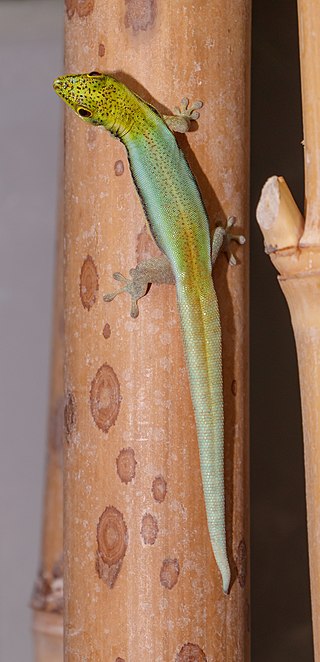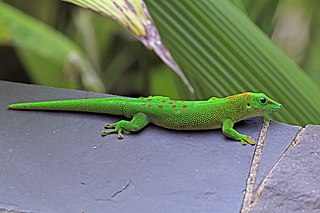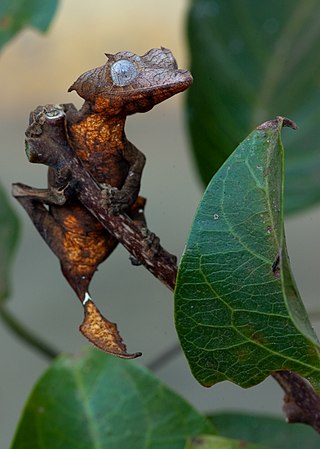
Phelsuma is a large genus of geckos in the family Gekkonidae. Species in the genus Phelsuma are commonly referred to as day geckos.

Barbour's day gecko is a species of lizard in the family Gekkonidae. The species is endemic to central Madagascar. It is diurnal and typically dwells on rocks. Barbour's day gecko feeds on insects and nectar.

The blue-tailed day gecko is a diurnal species of gecko, a lizard in the family Gekkonidae. The species is endemic to the island Mauritius. It typically inhabits warm and humid places and dwells on different trees and bushes.

The yellow-headed day gecko, also commonly called Klemmer's day gecko, the neon day gecko, or the cheerful day gecko, is a small diurnal species of gecko, a lizard in the family Gekkonidae. This endangered species is endemic to northwestern Madagascar and inhabits coastal forests, dwelling on bamboo. The yellow-headed day gecko feeds on insects and nectar.

Phelsuma grandis is a diurnal arboreal species of day gecko. These geckos are part of the Phelsuma group, which consists of in excess of 70 species and subspecies. They are commonly referred to as the Madagascar giant day gecko, due to their large size. They are native to areas of tropical and subtropical forest in northern Madagascar, but have been introduced to several other subtropical locations outside their range. P. grandis feeds on various invertebrates, very small vertebrates, and nectars. It is bred and sold as an exotic pet.

Seipp's day gecko is an endangered diurnal species of lizard in the family Gekkonidae. The species is native to northern Madagascar, typically inhabits rainforests, dwells on trees, and feeds on insects and nectar.

Paroedura is a genus of geckos, endemic to Madagascar and the Comoros. These geckos are typically terrestrial, though the young of most species can climb until they are too heavy for their feet to support.

Uroplatus is a genus of geckos, commonly referred to as leaf-tail geckos or flat-tailed geckos, which are endemic to Madagascar and its coastal islands, such as Nosy Be. They are nocturnal, insectivorous lizards found exclusively in primary and secondary forest.

The leopard gecko or common leopard gecko is a ground-dwelling lizard native to the rocky dry grassland and desert regions of Afghanistan, Iran, Pakistan, India, and Nepal. The leopard gecko has become a popular pet, and due to extensive captive breeding it is sometimes referred to as the first domesticated species of lizard.

Uroplatus ebenaui, commonly known as Ebenau's leaf-tailed gecko, the Nosy Be flat-tail gecko, and the spearpoint leaf-tail gecko, is a species of lizard in the family Gekkonidae. The species is native to Madagascar.

The common flat-tail gecko is a gecko endemic to Madagascar. It is found in eastern Madagascar and on the islands Nosy Bohara and Nosy Mangabe. These geckos live in tropical rain forests. They reach a total length of 330 mm.

Uroplatus phantasticus, the satanic leaf-tailed gecko, eyelash leaf-tailed gecko or the phantastic leaf-tailed gecko, is a species of gecko indigenous to the island of Madagascar. First described in 1888 by George Albert Boulenger, U. phantasticus is the smallest in body of the Uroplatus geckos, though there is an ongoing debate as to whether one of its cousins, U. ebenaui, is smaller because of its shorter tail.

The panther chameleon is a species of chameleon found in the eastern and northern parts of Madagascar in a tropical forest biome. Additionally, it has been introduced to Réunion and Mauritius.

Acrantophis dumerili, commonly known as Dumeril's boa, is a species of non-venomous snake in the family Boidae. The species is endemic to Madagascar. No subspecies are currently recognized.

Acrantophis madagascariensis is a species of boid snake in the subfamily Sanziniinae that is endemic to the island of Madagascar. Its common names include the Madagascar ground boa and Malagasy ground boa.

Uroplatus sikorae, commonly referred to as the mossy leaf-tailed gecko or the southern flat-tail gecko, is a species of lizard in the family Gekkonidae. The species is endemic to Madagascar. It is a CITES II protected animal due to habitat loss.

Paroedura masobe, also called masobe gecko, is an endangered species of reptile from the genus of geckos. They are the most abundant species in the Gecko family and are known for their white-speckled dark skin and big eyes. The average life span of the Paroedura masobe is approximately eight years. The average length of the masobe gecko is 0.16 m (6.3 in).

Phelsuma quadriocellata is a species of gecko known by the common name peacock day gecko. It is endemic to coastal eastern Madagascar, where it is a common to abundant, widespread reptile. This gecko lives in many types of low- to mid-elevation habitat types in Madagascar, including forests and areas with human activity such as cultivated land and human habitation. It is sometimes associated with Pandanus species.

Uroplatus sameiti is a species of leaf-tailed gecko. Like all members of the genus Uroplatus, U. sameiti is endemic to Madagascar, and is found in primary and secondary forests on the island. It has the ability to change its skin colour to match its surroundings and possesses dermal flaps which break up its outline when at rest.




















